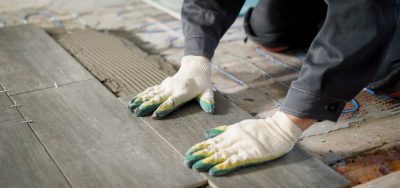- Oneflare /
- Cost Guides /
- Underfloor Heating

How Much Does Underfloor Heating Cost?
$30 - $115 per square metre
What's on this page
- Cost of Underfloor Heating
- How Much Does Floor Heating Cost Per m2?
- How Much Does Underfloor Heating Cost to Run?
- Factors Impacting the Cost
- Different Types of Underfloor Heating Prices
- Benefits of Underfloor Heating
- Hiring an Underfloor Heating Installer
- How to Save Money On Underfloor Heating
- FAQs
Read Related Underfloor Heating Articles
How Much Does Underfloor Heating Cost?
There are many areas to consider when looking at underfloor heating systems. Choosing an electric or hydronic heating system, the cost to install heated floors, and the type of flooring material used are examples of questions that will need to be answered. The average heated floor cost for installation in Australia is between $30 and $115 per square metre.
How Much Does Floor Heating Cost Per m2?
An underfloor heating installation is different from other heating options because it can involve plumbing. The installer must be qualified to work with plumbing, electricity, and heating. The cost to install hydronic heating differs according to location. The average cost for labour in Australia averages $25 per hour. Here are some examples of what it might cost in various areas around the country.
How Much Does Underfloor Heating Cost to Run?
One of your concerns might be how much it costs to run underfloor heating in the long run. Underfloor heating running cost depends on two factors: your electricity rate and the heat load of your heated floor. The average load is around 120 watts per square metre. The number is based on the total square footage of the area to be heated. Depending on the thickness of the concrete and heat properties of the floor, it can affect the running costs of the heater. If the heater must compete with moist, cold environments under the house, it can increase the running costs significantly.
Some actual figures place a price of a $50 increase per month when using underfloor heating systems in a small bathroom. The underfloor An electric underfloor heating price will always run higher than that of hydronic. The average electricity rate in Australia varies between 25c/kWh and 45c/kWh. Based on these rates, it can be estimated that the average underfloor heating cost will range between $20 to $150 per month depending on the various factors that have already been mentioned.
You will also want to figure in underfloor heating repair cost, too. The worst-case scenario is a broken pipe. If this should happen, it might be necessary to break up a concrete floor to make the repair. Ease of access is a significant factor in how much it will cost to repair the system, should something go wrong.
Factors Impacting the Cost of Heated Floors
Hydronic vs electric
Hydronic floor heating cost is significantly less than electric, but has its drawbacks. You cannot turn on and turn off hydronic floor heating instantly. It takes approximately two days for a hydronic floor to reach the desired temperature. This can feel great on chilly mornings. However, the floors will not cool down as the day becomes warmer, and the heated floors cost may not be necessary. Electric heated floors are quick to cool down as the coils are close to the surface.
Type of Underfloor Heating Method
There are three types of electric underfloor heating methods.
- In-slab takes the heating wires and places them within the concrete of a floor. The concrete is heated by a thermostat and delivers heat to whatever floor material is placed on top.
- In-screed uses sand and gravel to form a lid over the concrete layer. The heating wires are then placed atop the screed, making heat delivery faster by not having to travel through concrete coatings.
- Under-tile uses thin wires that lie directly below the flooring material for faster heating.
New Building or Old Building Installation
It can be cost-effective to use a hydronic underfloor heating system because of the underfloor heating running cost per square metre. This type is significantly less than that of electric. This method works well with today’s natural stone, keeping floors a steady temperature, or if you are working on a large area. Older buildings do not have the luxury of pouring new concrete, and the in-screed or under-tile methods are popular.
Flooring Type
Not all flooring types can sustain the heat from underfloor heating coils. Pads can be used for most carpets, and most tile or engineered wood is made to work with underfloor heating methods. However, always check with the manufacturer to ensure that your flooring will not buckle under regular use.
An underfloor heating system can be installed with any type of subfloor. The only difference in cost is how much work is involved and the building codes involved for each type of floor. It can be installed on a concrete floor, wood floor, or underneath carpet on top of the subfloor. You can also install it under stone or tile. Some types of installations are more costly than others.
Removal of Tiles or Existing Flooring
If you decide to install underfloor heating in a new build, then it will be less expensive than deciding to do it as an afterthought. If you install it into an existing home, you will have to either have to tear up the old concrete or pour another layer on top.
Sometimes, the new system can be laid on top of the floor and then covered with a thin layer of concrete, which is called an ‘in screed’ installation. This raises the height of the floor slightly, and things such as doors and cabinetry will have to be adjusted to fit. These can add significantly to the labour involved in the job and drive up the costs due to the extra hours involved.
Price Estimates for Different Types of Underfloor Heating
The underfloor heating cost can vary according to the method, location and size of the job. The cost of underfloor heating may change depending on the type of professional you hire. Contractors, plumbers and electricians are the most common installers for heated floors. Here are the main types of underfloor heating:
Electric. Electric underfloor heating works by way of a system of heating coils installed under the floor. An in screed electric heater costs around $115 per square metre. In comparison, an in-slab heater costs around $40 per square metre. You can also get a programmable digital thermostat for around $200. The type of power supply will also affect the cost of installation. You can choose a conventional hook up to the grid, or you can choose solar.
Hydronic – Hydronic heating uses tubes filled with water to carry the heat to the rest of the house. The hydronic underfloor heating cost can be the most expensive to install, but it is often the least costly to operate in the long run.
In screed – In screed systems involve putting a thin layer of concrete over the installed pipes or electric heating coil. This is often the most expensive installation and can cost around $115 per square metre.
In slab – An in-slab system is often sandwiched between two layers of concrete. If you have it installed in a new build, it averages around $70 per square metre.
Under tile – Many people choose to install underfloor heating underneath a tile floor. Heated tile floor cost can be expensive, depending on the type of tile or stone that is chosen. However, because of the heat retention properties of stone, it can be inexpensive to operate over time.
Benefits of Underfloor Heating
The number one reason for having underfloor heating is comfort. Your feet are warmed, especially on tile or stone, allowing you to run around barefoot. Other benefits include:
- Heat is evenly distributed to eliminate cold spots.
- Larger areas are comfortable at lower heat settings.
- Heated floor cost is less to operate than a standing radiator.
- There are no bulky heating devices because underfloor systems are hidden.
- Underfloor heating price, as opposed to forced air, is a high selling point.
- Reduces allergens in the home.
There are some cons in underfloor heating, however.
- Underfloor heating installation cost is more expensive than traditional heating methods.
- Depending on where you live in Australia, your electric underfloor heating cost can drive up your monthly bill.
- Hydronic underfloor heating cost installation can be a significant investment.
- Care must be taken in placing furniture over flooring that is heated.
How to Hire an Underfloor Heating Installer
The cost of underfloor heating installation is based on skilled labour. Never hire an inexperienced person to save on your underfloor heating system cost. The right installer can make the difference between a higher electric bill or a lower one. When properly installed, your floor heating price can be reduced due to the projected area. However, your electric floor heating cost can be expensive if not installed correctly.
Make sure the underfloor installation company that you call can provide:
- Company longevity
- References
- Electrical licensing
- Guarantee on work
- Warranty on products
How to Create an Accurate Estimate
- Let your professional know the approximate size of the area where you would like to install the underfloor heating.
- Know whether your floors are concrete, wood, or have tile or laminate surfaces.
- Be ready to answer any questions that your professional might have about the age of your home, age of the electrical system, and your water supply.
Licencing and Qualifications
A different licence might be required, depending on the type of system that you have installed. For an electric system, your installer will need certification as a general contractor and as an electrician. If you install a hydronic system, the professional will also have to have a plumber’s licence. You will need to check with local and state regulations that apply to you. Here are a few questions that you might want to ask before choosing your professional.
- Do you hold the needed licences to perform all phases of the installation process?
- Will you need to use any outside contractors for any portion of the project?
- Do you have references that can be contacted?
How to Save Money on Underfloor Heating
There are many things to consider and DIY if you want to save on underfloor heating. Particularly if you have existing flooring. Here a few main ways to save as much as you can on your underfloor heating investment:
Timing – Because underfloor heating is integrated into the structural components of the house, it will cost you less if you install it during renovation, rather than after. If you choose to install it afterwards, the floor might have to be taken out or damaged. Doing it during renovation avoids this extra demolition stage.
High ceilings – If you have high ceilings, it might be wise to install a lower ceiling or to provide additional insulation. Because heat rises, it can easily escape or hang near the ceiling, leaving the rest of the room where you are cold.
Partial Installation – One idea to save money is to just install the heating where it is needed the most instead of under the whole floor. For instance, you might install it just outside of the bath or by the toilet. You might also install it so that you have a warm floor to step onto by the bed.
Removal of existing floors – The most significant part of any underfloor heating job is preparing the base. If you are looking at a remodel in an older home, inquire as to pulling up and removing the old flooring. This could save a ton of money in installation fees.
Creating an accessible space – Make the area as accessible as possible for the installers to get their work done. Any type of work comes down to the amount of time that is spent. Help them to get in and get done as quickly as possible.
Frequency Asked Questions
Is the average cost of underfloor heating worth the time and money?
For a region where there are temperature fluctuations, the answer could be no. With hydronic floor heating, the pipes are buried into the concrete. By the time the heat spreads evenly throughout the cement, changing weather patterns could make the extra heat quite uncomfortable. With consistent weather, though, the warmth can be a real benefit.
Do I need to install underfloor heating across the whole room?
One of the advantages of underfloor heating is that you do not have to install it under the floor of the entire room. Underfloor heating price is considerably less when you only install it under part of the floor. For instance, if you only spend time in one area of the room, you can choose to only install it in that place.
Is partial underfloor heating a common choice?
Partial underfloor heating is a common choice for cost reasons. In addition, you do not have to pay for heating in an area of the home that you do not use often. You can choose to only heat the areas that you need the most. This can be an excellent choice for zone heating.
* The cost data is based on Oneflare and third-party sources


